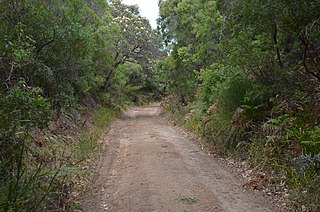Related Research Articles

Bunbury is a coastal city in the Australian state of Western Australia, approximately 175 kilometres (109 mi) south of the state capital, Perth. It is the state's third most populous city after Perth and Mandurah, with a population of approximately 75,000.

Edith Cowan University (ECU) is an Australian public university located in Perth, Western Australia. It was named after the first woman to be elected to an Australian Parliament, Edith Cowan, and is the only Australian university named after a woman.

Busselton is a city in the South West region of the state of Western Australia approximately 220 km (140 mi) south-west of Perth. Busselton has a long history as a popular holiday destination for Western Australians; however, the closure of the Busselton Port in 1972 and the contemporaneous establishment of the nearby Margaret River wine region have seen Tourism become the dominant source of investment and development, supplemented by services and retail. The Town is best known for the Busselton Jetty, the longest wooden jetty in the Southern Hemisphere.

The Flinders Bay Branch Railway, also known as the Boyanup to Flinders Bay Section ran between Boyanup and Flinders Bay, in South Western Western Australia. The section from Flinders Bay to Busselton has now been converted into a rail trail for bushwalkers and cyclists, called the Wadandi Trail.
Maurice Coleman Davies was an Australian timber merchant and pastoralist. Born in London, he emigrated to Tasmania with his family as a child, and later moved to Blackwood in the Victorian goldfields, then to Melbourne and Adelaide. He then relocated to Western Australia, where he created the M. C. Davies Company, later the M. C. Davies Karri and Jarrah Timber Company, a timber empire that employed hundreds of men, laid over a hundred kilometres of private railway, including the Flinders Bay Branch Railway, and even built its own private ports for exporting of timber. He also formed the Kimberley Pastoral Company and was its managing director.

Godfrey Blow is an artist based in Kalamunda, Western Australia. He is the founder of the Perth Stuckists.

The South Western Railway, also known as the South West Main Line, is the main railway route between Perth and Bunbury in Western Australia.
Phillip George Pendal was a Liberal and later Independent Western Australian politician, pro-life advocate, and historian.
Bill Bunbury is a former radio broadcaster and producer for the Australian Broadcasting Corporation, and an accomplished historian and writer.

Bunbury Senior High School is a comprehensive public co-educational high day school, located in Bunbury, a regional centre in the South West region, 175 kilometres (109 mi) south of Perth, Western Australia.

W.A. Timber Company was a syndicate of Victorian investors granted a timber concession of 181,500 acres on Geographe Bay in the south west of Western Australia in 1870.
Millars' Karri and Jarrah Company (1902) Limited, commonly known as Millars, was a Western Australian focused timber and timber railway company.
Malcolm John Bryce was an Australian politician, who served as a Labor Party member of the Legislative Assembly of Western Australia from 1971 to 1988, representing the seat of Ascot. He was deputy leader of the Labor Party from 1977 to 1980 and from 1981 to 1988, and served as deputy premier under Brian Burke.

Bunbury Bridge was a single-track, timber railway bridge in East Perth in Western Australia. The bridge crossed the Swan River near Claise Brook and was built for passenger and freight traffic to Bunbury on the South Western Railway, and was also part of the Armadale railway line.
Ross Mewburn Elliott was an Australian journalist and politician. He was a Liberal Party member of the Legislative Assembly of Western Australia from 1965 to 1968, representing the seat of Canning.
David Lawrence Smith is a former Australian politician who was a Labor Party member of the Legislative Assembly of Western Australia from 1983 to 1996. He served as a minister in the governments of Peter Dowding and Carmen Lawrence.
John Sibson was an Australian politician who was a Liberal Party member of the Legislative Assembly of Western Australia from 1973 to 1983, representing the seat of Bunbury.
William Spencer was an early settler of Western Australia. Arriving in Bunbury from England in 1842, he remained in the area for the rest of his life, serving several terms as the town's mayor. He was elected to the colony's Legislative Council of Western Australia in 1896, serving until his death.
Donald Thomas Punch is an Australian politician. He has been a Labor member of the Western Australian Legislative Assembly since the 2017 state election, representing Bunbury.

WAGR G class G233 Leschenault Lady is a preserved 2-6-0 steam locomotive, built in 1898 by James Martin & Co of Gawler, South Australia, for the Western Australian Government Railways (WAGR). It is believed to be the oldest Australian-built steam locomotive still in operational order.
References
- ↑ D Black and G Bolton, eds, Biographical Register of Members of Parliament of Western Australia: volume two 1930-2010, Western Australian Parliamentary History Project, WA, 2011, p.239
- ↑ "MP Historical Data". Parliament.wa.gov.au. Retrieved 26 September 2015.